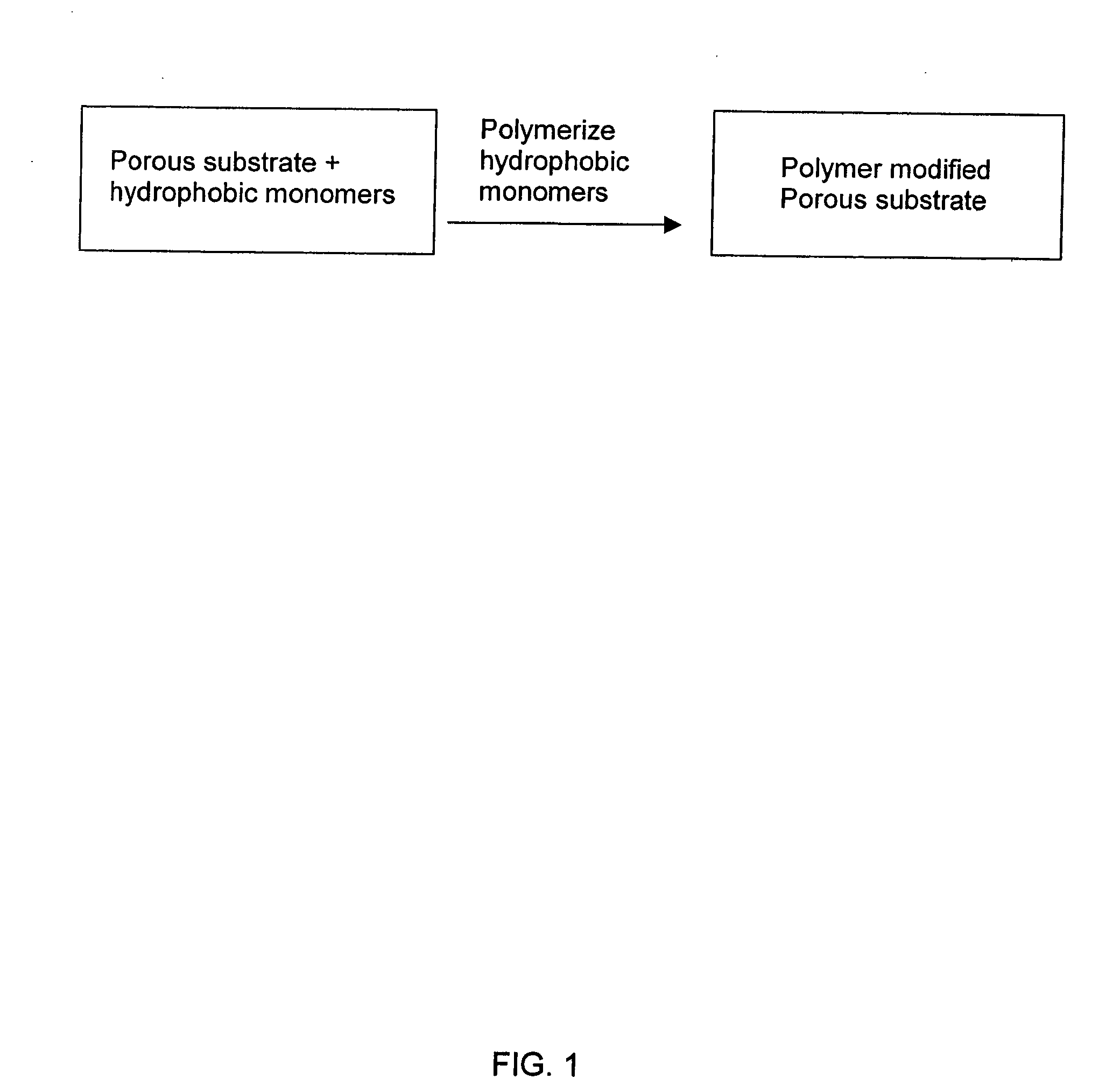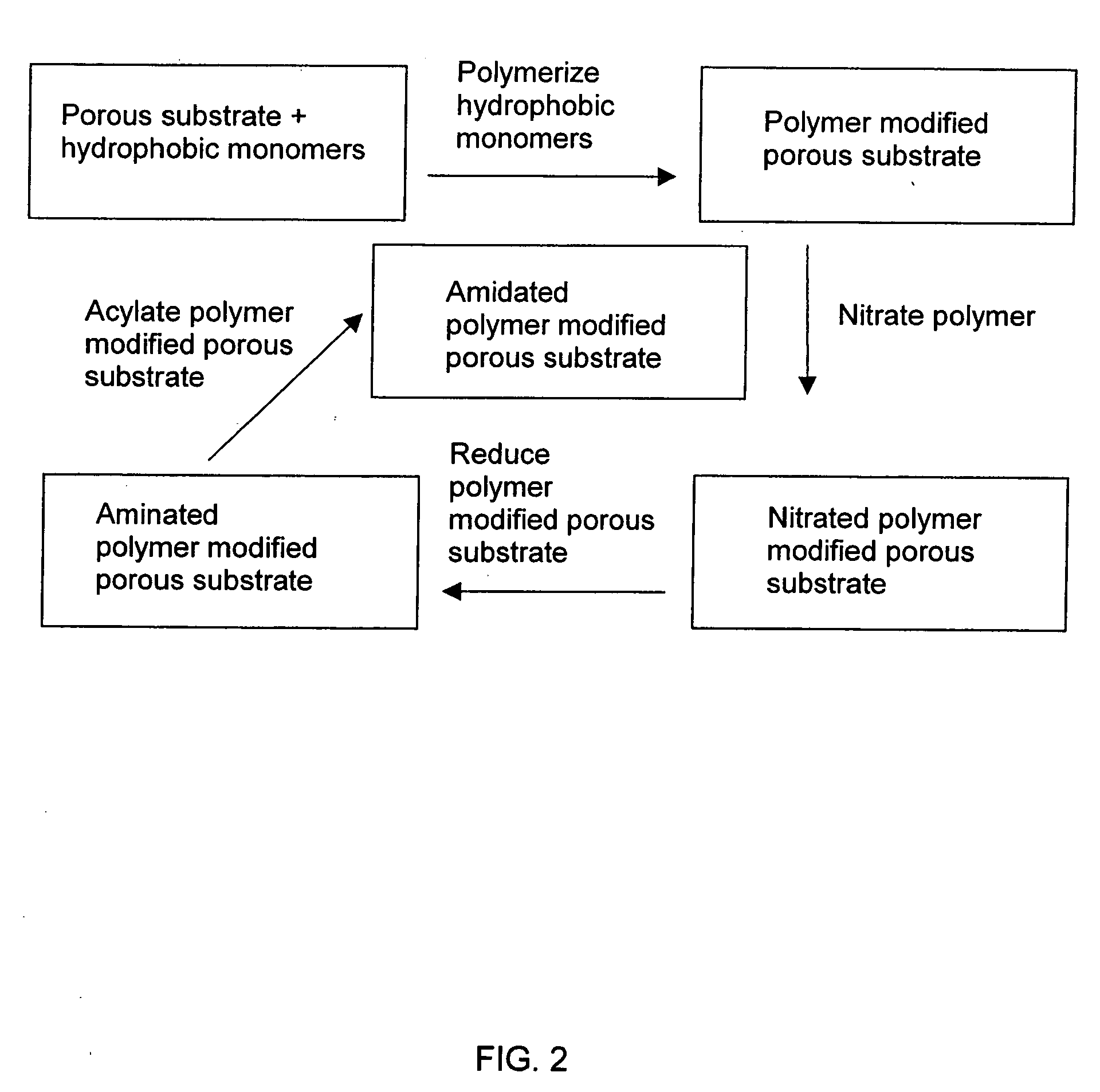Polymer modified porous substrate for solid phase extraction
- Summary
- Abstract
- Description
- Claims
- Application Information
AI Technical Summary
Benefits of technology
Problems solved by technology
Method used
Image
Examples
example 1
Preparation of a Polymer Modified Porous Substrate
[0104] A PSDVB modified glass fiber monolith was prepared by the following procedures. The reaction is depicted in schematic fashion in FIG. 1.
[0105] A polymer forming solution was prepared containing styrene (10 mL), divinylbenzene (10 mL), 1-decanol (26 mL), tetrahydrofuran (4 mL) and azobisisobutyronitrile (200 mg) (AIBN) and stirred in a beaker until dissolved, then the mixture was poured into a wide container (a plastic tray). The mass of an approximately 4.5″×3.0″ piece of glass fiber media was determined and recorded, and then immersed into the above prepared monomer mixture for about 7 minutes. The saturated glass fiber was removed from the tray and allowed to drip for about 1.5 minutes to remove any excess reaction mixture. The solution saturated glass fiber was placed into an appropriate container (a vented desiccator without desiccant) having a means to support the glass fiber. The container was purged with dry nitrogen ...
example 2
Preparation of an Amide Functionalized Polymer Modified Porous Substrate
[0106] A PSDVB modified glass fiber monolith was amidated by the following procedures. The reaction is depicted in schematic fashion in FIG. 2.
[0107] A. A nitration step was performed as follows: the PSDVB modified glass fiber monolith prepared in Example 1 was suspended in concentrated nitric acid (30 molar equivalents) and the mixture was mechanically stirred. While cooling the mixture in cold water, concentrated sulfuric acid (18 molar equivalents) was added dropwise over a period of 1 to 1.5 hours, continuing the stirring at the same time. The mixture was further stirred at room temperature for three more hours. The modified glass fiber monolith was removed and immersed in water, and allowed to stand for a couple of hours, and was then washed with 2.0M NaOH, deionized water and acetone, and dried in an oven at 70° C. for 24 hours.
[0108] B. A reduction step was performed as follows: the nitrated PSDVB glas...
example 3
Elemental Analysis of Polymer Modified Monoliths
[0110] The amide functionalized polymer modified glass fiber monolith described in Example 2 PSDVB-NHCOCH3, and the PSDVB modified glass fiber monolith prepared according to Example 1 (i.e., prior to the nitration, reduction and acetylation steps), were subjected to elemental analysis. Elemental analysis for the amide functionalized polymer modified glass fiber monolith, PSDVB-NHCOCH3, showed 48.37% carbon, 4.02% hydrogen and 2.55% nitrogen, with the remaining composition being silicates. The glass fiber monolith modified with PSDVB alone had negligible nitrogen content (N <0.02%).
PUM
| Property | Measurement | Unit |
|---|---|---|
| Flow rate | aaaaa | aaaaa |
| Diameter | aaaaa | aaaaa |
| Polarity | aaaaa | aaaaa |
Abstract
Description
Claims
Application Information
 Login to View More
Login to View More - R&D
- Intellectual Property
- Life Sciences
- Materials
- Tech Scout
- Unparalleled Data Quality
- Higher Quality Content
- 60% Fewer Hallucinations
Browse by: Latest US Patents, China's latest patents, Technical Efficacy Thesaurus, Application Domain, Technology Topic, Popular Technical Reports.
© 2025 PatSnap. All rights reserved.Legal|Privacy policy|Modern Slavery Act Transparency Statement|Sitemap|About US| Contact US: help@patsnap.com



